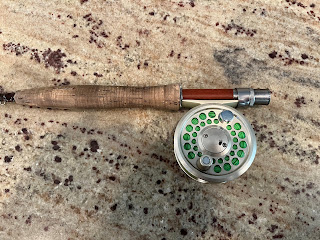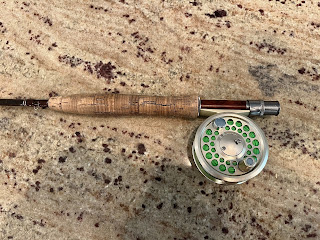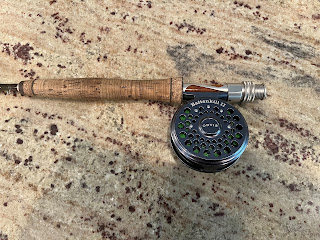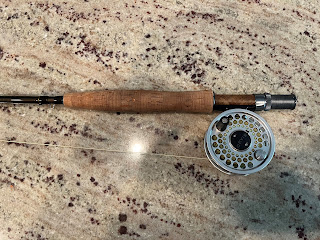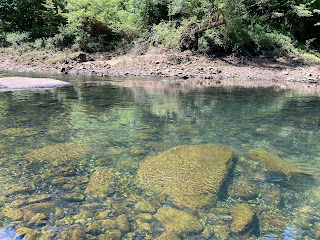Guys, you've noticed it's been a while since I posted anything on my blog. Cathey and I have been busy helping our daughter's family with their new arrival. Last Thursday, Jenny gave birth to a beautiful eight-pound baby girl.
I hope to use this blog as an avenue to express my thoughts and adventures of all of my fishing expeditions and any other journeys I may undertake.
Tuesday, September 6, 2022
Fly Fishing the Hopper
Sunday, August 7, 2022
The Redworm and the Fly Rod
Most fly fishermen will tell you they don't use live bait when fishing with a fly rod. I've never seen anyone using live bait fishing with the flyrod on the Sipsey. I have seen many individuals on the Sipsey using a spin cast fishing with redworms, corn, or crappie nibbles.
Live bait works when artificial flies and lures will not produce. Just ask my daughter about the success of live bait fishing when she would go with me years ago and fish the many nooks on Smith for bluegill, catfish, and bass. She was more into live bait fishing than my son.
Saturday, June 25, 2022
The Versatile Caddis Fly
When one thinks of the Caddis Fly they relate it to fly fishing for trout. I have fished this fly numerous times on the Sipsey mainly using it as an indicator fly. There were times when I would get a trout to inhale the Caddis while slow drifting a nymph under it. Which was a plus because I was trying to get the trout to take a smaller nymph drifting below. I use the traditional dry-dropper combo more now on the Sipsey because of the fishing pressure. I remember previous years fishing the Sipsey I never used the dry-dropper combo. I only fished a nymph using the various strike indicator on the market.
On my last trip to the Sipsey, which was a bust for me, no trout touched; started me thinking of using this fly to fish for the giant bluegill on Smith Lake. So two weeks ago, I gave the fly a try casting it near the rock walls in Ryan Creek.
Sunday, June 5, 2022
Every Minute Counts
Daylight and right before the sun goes down are some of the best times to land fish fishing for warm water or cold water species. I prefer the daylight hours in the summer months because there is little humidity during daylight. One still has to deal with humid conditions late in the evening before dark.
Jeff and I found out just how pleasant the daylight hour was this past Thursday as we fished one of the floating lights near the many piers in Ryan Creek.
Thursday, May 19, 2022
Addicted to the Gills
I know many of you think I am obsessed with the bluegill. All the post I have published on my blog proves that statement. I never tire of landing the big bulls, especially in the super clear deep waters of Smith Lake.
What makes landing these supersize gills special is how they attack the surface popper. An explosive hit is what one can expect from this size gill, making you think it is a spotted bass. The minute they inhale the popper they go for deep water. The fight even with a 5 wt. is awesome and even more epic using a 3 or 4 wt. In other words, you just don't jerk these fish in the boat. I lost one of the largest gills yesterday I think I have ever connected with fishing Smith using a 3wt. I saw the bluegill and knew he was huge but didn't realize how powerful the fish was until it broke my 5X tippet. Today's catch helped relieve the pain of losing that fish yesterday.Tuesday, May 10, 2022
Finally a Day on the Sipsey
Wednesday, May 4, 2022
Fish--an Excellent Meat Choice
One would assume that most all meats are a good source of protein. Beef, Pork, Chicken, Fish, and Turkey are the most common. Fish, Turkey, and Chicken are the three types of meat Cathey and I eat. I no longer eat red meat since being diagnosed with a blockage in my left descending artery some 12 years ago. 2010 was the year the blockage was discovered. The Doctors told me 40 to 50 percent blockage didn't warrant a stent. They recommended a yearly checkup and lots of exercise in the form of walking and a diet filled with fruit and vegetables. Cathey and I thought we were eating healthy at the time walking fairly regularly before this diagnosis but apparently not. As was the case with most all of us when we were younger meals were fast foods and eat-outs loaded with fats. In other words, the bad foods over the years showed up in that arteriogram done in 2010.
My Cardiologist told me on my last visit that test studies prove now with diet and exercise blockage can be decreased if it is not severe. By the way, I am not part of that study, but I gladly accept the findings. I've come to realize as we all get older we need to be much more active. That is the key to keeping all of us on the water even into our 80s!!-----
These bluegills were landed last week using the light 2/3 weight fly rods. All were taken early in the morning on top. Excellent meat source just as the title of this blog post states. Thursday will be my first visit to the Sipsey since last year because of generation. I hope the water is at the level I can wade---wish me luck !Tuesday, April 5, 2022
Weather Past and Present
Weather conditions have changed drastically since I was a boy growing up in Mississippi years ago. We are seeing many more tornados and hurricanes today compared to what my brother and I used to call the good old days. The good old days are for another post. With tornadoes and hurricanes come heavy rains, wind, and flooding. It seems we have four or five days of great weather then all hell breaks loose for a couple of days with tornadoes in fact, as I type this post we may be under a tornado watch tomorrow. We are in this cycle through all of Spring.
So, what does a weary fly fisherman do when he can't trout fish------the images above show the answer! I fillet 14 of these pre-spawn beauties and threw back a bunch of future bull gills fishing Walker Lake yesterday.
I have started wearing Orvis fishing gloves. I had two sunspots removed from the top of my hands in the winter months and one sun growth from the top of my head. My Dermatologist told me I needed to start protecting myself much more from the sunray when I'm on the water.
Wednesday, March 16, 2022
It's Not About The Fish Sometimes
The Grandchildren were having their Spring break this week which gave their Mom and them an opportunity to come and visit their Meme and Pops. Their Dad couldn't make the trip because of work. Their next trip in the summer will bring the whole family. Our Grandchildren are the center of our lives just as our children were when they were growing up.

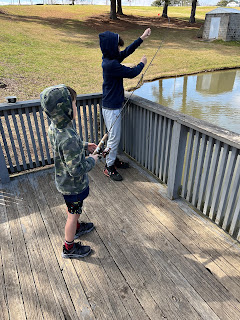


Monday, February 21, 2022
Remembering a Great Fly Fisherman and Friend
I was surprised to hear of Alan's passing of "Small Streams Reflections"--my heart is broken to hear this because he was like a brother to me. I look forward every week to one of his inspiring posts concerning fly fishing, tasty meals, and colorful outdoor images. I felt he was the glue that held all of us bloggers together now, he's gone but not forgotten.
I'm thankful I have numerous flies and streamers he tied for me and my son Jason. I did a post some months ago concerning the colorful streamers he tied for Jason's Christmas a couple of years ago. My condolences to his wife Jennette and children
This picture is hanging in Jason's house and will always whole special meaning for Jason and ISaturday, January 29, 2022
Pairing Fly Rods With Fly Reels
When some individuals buy a fly rod they like to pair it with a fly reel that gives them balance with the reel size, its weight, and the weight of the fly rod. When it comes to balancing a fly reel and fly rod it all depends on where you move your forefinger on the cork handle to get the reel and rod to sit in a straight horizontal position. I know a lot of you guys use this method to balance a combo you are purchasing and a lot of fly fishing shops adhere to this method.
Monday, January 10, 2022
My Other Social Media Outlet
As most of you know winter is not a season I look forward to. Why, because trout fishing is practically none existence on the Sipsey because generators run constantly. You guys that fish the native trout streams are so lucky. No generators to contend with, only a heavy rain that might cause the stream to rise some, but is back to normal flow in a day or two. How I wish I had that type of stream to fish here. So to satisfy my lack of trout fishing I watch Utube fly fishing videos. I have established quite a few contacts interacting with guys who post some great fly fishing videos. Not only are their videos entertaining but educational as well. The following videos are some of my favorites:
Drew Looknfishy---- Drew has a blog by the same name but never publishes posts anymore on his blog because he has quite a following on Utube now. His videos feature small stream fishing out west during the late spring and summer months.
Hardman Fishing Adventures ------This is a young guy that makes all of us seniors wish we were young again and could balance walking logs across streams and hiking miles on some of the most beautiful trout streams in the northeast.
Jensenflyfishing -----Dave and Amelia are husband and wife who fish for huge trout in Canada and Ontario -----amazing how well they get along and work together to land some colorful brook, browns, and rainbow trout!
George Daniel ---- this guy knows more about Euro Nymphing than anyone I've watched on Utube. I hope I can get to use some of his Euro techniques on the Sipsey if I ever get to fish it again. George does most of his fly fishing in Pennysaliva's native streams.
Old Dominion Trout Bum------Cory, lives in Virginia and fishes small streams and tailraces in six different states north of him all the way to Maine. He only fishes the Euro technique and is very good at it!
And last----Scotty's Gone Walkabout----This guy takes overnight camping to another level all over Australia. He is in the process of learning how to fly fish as he hikes through the mountain terrain of Australia.
Most of these guys post a video at least once every two weeks.
Wednesday, December 15, 2021
Reminisicing
As I get older I find myself reminiscing more about my childhood growing up in Choctaw County in Mississippi. My fondest memories were fishing the two streams that flowed through our property near our house. One of the streams was near our pond that we fished and swim in. My younger brother and I would walk the banks of the streams in the summer and spring looking for pocket holes that held sun perch and yellow catfish. The catfish could put a bend in our hand-made 9 and 10 ft. cane poles. We didn't realize it at the time but we were tight-lining without a cork. We seldom used a cork because the spots we were trying to fish were well hidden with brush and limbs. We would shorten our line on the cane poles at times to gently stick the end of the pole right above the surface of the hole and wait for a tug on the redworm we use as bait. We would always land our best fish using this method. Redworms were our go-to bait when fishing the creeks. Little did know at the time that the tight line method we use as young boys would be used by me to fish for trout one day. True the cane pole method wasn't as refined as the fly rod, but still is was successful.
We would watch my Dad land bluegill and bass with the fly rod and be amazed at how far he could cast a popper. Dad used an 8 1/2 ft. Southbend fly rod paired with a Daiwa fly reel. My brother and I got to use Dad's fly rod only when he had time to give us pointers on how to cast. We found out that our cane pole could be used as a fly rod and much easier to cast. We used a monoline as long as the cane pole. We use green grasshoppers as our fly casting it as far as we could fishing the small creek that flowed into our pond. We would land small rock bass hiding near the undercut banks of the little stream. As quickly as the grasshopper vanished we would jerk the pole upward and the little fish would fly over our heads. It was always a contest to see who landed the largest little fish. We didn't realize it then but we were using a scale-down Tenkara rod. I am so glad that my brothers and I were raised to enjoy the outdoors in the form of fishing, hiking, and hunting----memories I will never forget!
As the winter months close in it gives me time to look back on this past year and wonder how I will approach the coming season. Where will I be casting my flies and poppers this next season? I hope I get to fish the Sipsey more this coming season!!!!------------Here's wishing you all a Merry Xmas and Happy New Year!
Thursday, November 11, 2021
The Sink Tip Poly Leader
Tuesday, October 26, 2021
Survival of Stocked Trout in Tailwaters
I received an email the other day from one of my fly fishing buddies concerning stocked rainbow trout in the Sipsey Tailrace that we fish. The email contained a study conducted by an Auburn University student in partial fulfillment for a Degree of Masters in Science.
Hypolimnetic discharge waters (the layer of water in a thermally stratified lake that lies below the thermocline, is noncirculating, and remains perpetually cold) from reservoirs in the southern U.S. provides water temperatures cold enough to support Rainbow Trout fisheries in regions where they otherwise could not exist. The Sipsey Fork tailwater in Alabama provides such an opportunity and is stocked with Rainbow Trout monthly. In a recent survey, less than 25% of the Rainbow Trout stocked each month were harvested and few trout appeared to persist in the system for more than 3-4 weeks. The objective of this study was to describe post-stocking dispersal and the fate of the non-harvested Rainbow Trout. In March, June, and October 2017, and January 2018, numerous Rainbow Trout were radio-tagged and tracked to document movement patterns and to determine longevity in the tailrace. Tagged Rainbow Trout had dispersed an average of 4.1 km or 2 .54 miles with only 30% of tagged Rainbow Trout remaining alive five weeks after stocking. The extent of predation on Rainbow Trout was assessed using a bioenergetics approach. Electrofishing surveys and diet analysis of predators identified Striped Bass as the primary predators of Rainbow Trout in the Sipsey Fork. Bioenergetics simulations revealed that approximately 500 Striped Bass living continuously in the tailwater from March through October could consume all Rainbow Trout stocked each month. Knowledge regarding the dispersal and fate of stocked Rainbow Trout in this system can improve the management of the fishery.
This study proves what a lot of us who fish the tailrace have known for some time that the Striped Bass consumes a large number of the trout once they move beyond the pump station. I have never seen Striped Bass above the pump station which is where a lot of the fly fishermen wade. All the guide trips take place above the pump station. There is less than a quarter of a mile of prime trout fishing from where the trout are released to the pump station. The rest of the tailrace is much too deep to wade. I feel the deep water below the pump station is where most all the trout are consumed by Striped Bass. 1100 to 1200 pounds of trout are released in the tailrace each month which could equal to 1000 trout or below depending on the size of the trout. Consider how many trout would be left in the quarter-mile wading section if trout were released every couple of months.
I respect the findings of this study but see little chance of reversing the effects the Striped Bass have on trout that is stocked in the Sipsey.
Monday, October 18, 2021
The Bluegill, Start to Finish
The bluegill is probably the most common warm water fish caught throughout the United States. A lot of us started fishing as youngsters fishing for the bluegill. These fish will hit almost anything that moves in the water. I remember catching this fish as a boy fishing from the bank in our pond near our house. The first fish my grandchildren landed when they started fishing was the bluegill. Any size bluegill will produce a bend in the light fishing rod. The excitement on the face of a small child landing bluegill is priceless. I know I have witnessed that excitement.
Bluegill and Crappie are the only fish I keep to dress for table fare. Both these fish are excellent to eat if they are dressed and prepared right. I'm not a fan of the so-called tried and true method of cleaning these fish. Scraping the scales off their sides and cutting their heads off is how we prepared them for the skillet years ago. My family and I thought they were delicious to eat at the time.
It took years for me to discover that a filleted fish has a much better taste than a fish fried whole with the skin and bones. You eliminate the fishy taste when the skin and bones are removed from the fish. I filleted my first bluegill 45 years ago one afternoon on the back porch of my school Principals house, dressing bluegill we had landed that afternoon. The first fish I filleted on my own wasn't perfect but over time I mastered the process.
The Receipt for delicious bluegill and crappie
Take all fillets and place in a pan with water and add 3 to 4 tablespoons of salt and stir until all the salt is dissolved into the fillets---let sit overnight in the frig--the salt removes all the blood from the fillets
Remove the fillets the next day and wash all the salt off the fillets
Spray a cookie sheet with pam and coat all the fillets with cornmeal mixed with lemon pepper, salt, and black pepper
Bake all the fillets on 450 in the oven and turn the fillets over in about ten minutes and continue to bake until done. The process of baking the fillets takes about 20 minutes or less. You want the fillets to be tender and not overly baked which will make them tuff.
For those of you who like the fillets fried use a fry daddy adding Crisco, or Coconut oil to fry the fillets until they are golden brown--remove the fillets and let set on a paper towel to drain the oil
French fries, coleslaw, and hushpuppies are all sides dishes that are delicious to eat with the fillets. Don't forget the tartar sauce and catsup---almost forgot a cold beer to top the meal off!!
Enjoy the meal!







.jpg)

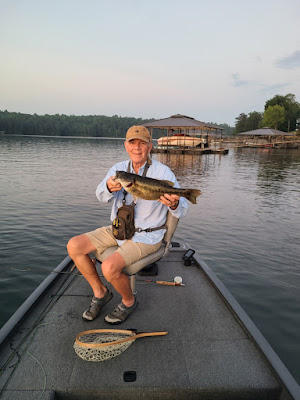
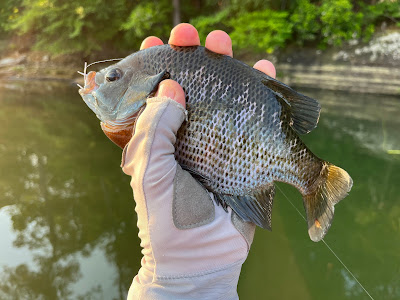






.jpg)











